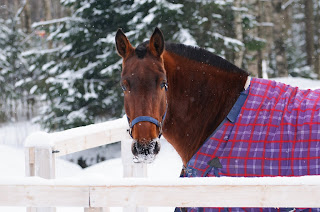Moody mares may benefit from ovariectomy to alter their
behaviour and rideability, according to a recent report.
Some mares are difficult to manage and perform poorly as a
result. They may be uncooperative or aggressive when handled on the ground. They
may kick, buck or rear when ridden or may be aggressive towards other horses.
Unwanted behaviour may result from pain from orthopaedic or
other sources. Sometimes it is related to the mare coming in season, in which
case it may be improved by suppressing the oestrus cycle.
Some ovarian tumours, although less common, may produce
similar effects. Treatment of these cases is likely to involve removing the
affected ovary (ovariectomy).
But sometimes there is no obvious explanation for the unwanted
behaviour. Would removing both ovaries (bilateral ovariectomy) help?
A study by Daniel Taasti Melgaard, of the Horsholm Equine
Clinic, Fredensborg, Denmarkand colleagues looked at whether removing the
ovaries from mares with unexplained unwanted behaviour improved the mare’s
behaviour or rideability.
Twenty-eight mares underwent surgical removal of both
ovaries once the clinicians had ruled out painful causes and after the mares
had not responded to a trial period of hormone therapy to suppress oestrus
behaviour.
Owners reported that, after bilateral ovariectomy, 80%
(8/10) of mares with normal ovaries and 57% (8/14) of mares with ovarian
neoplasia were easier to ride. Behaviour was reported to be better in 40%
(4/10) of mares with normal ovaries, and in 43% (6/14) of mares with ovarian
neoplasia.
A full, open access, report is published in the journal
Animals.
The authors emphasise the importance of a thorough
diagnostic work up to rule out other conditions, such as orthopaedic,
alimentary, vaginal or uterine pathology, before considering ovariectomy for
unwanted behaviour.
They suggest that, despite the significant improvement
observed in the present study, further research is necessary to confirm whether
mares with unwanted behaviour not obviously related to the oestrus cycle and to
painful conditions may benefit from ovariectomy to alter their behaviour and
rideability.
“In conclusion”, they write, “a significant improvement was
observed in rideability and behaviour post- ovariectomy, but no statistical
difference in improvement after ovariectomy between mares with ovarian
neoplasia and mares with histopathologic normal ovaries was observed. The
results suggest that mares with and without neoplasia can equally benefit from
ovariectomy to improve behaviour and rideability.”
For more details, see:
Moody Mares - Is Ovariectomy a
Solution?
Daniel Taasti Melgaard, Trine
Stokbro Korsgaard, Martin Soendergaard Thoefner, Morten Roenn Petersen, Hanne
Gervi Pedersen.
Animals (Basel) (2020)
doi: 10.3390/ani10071210





